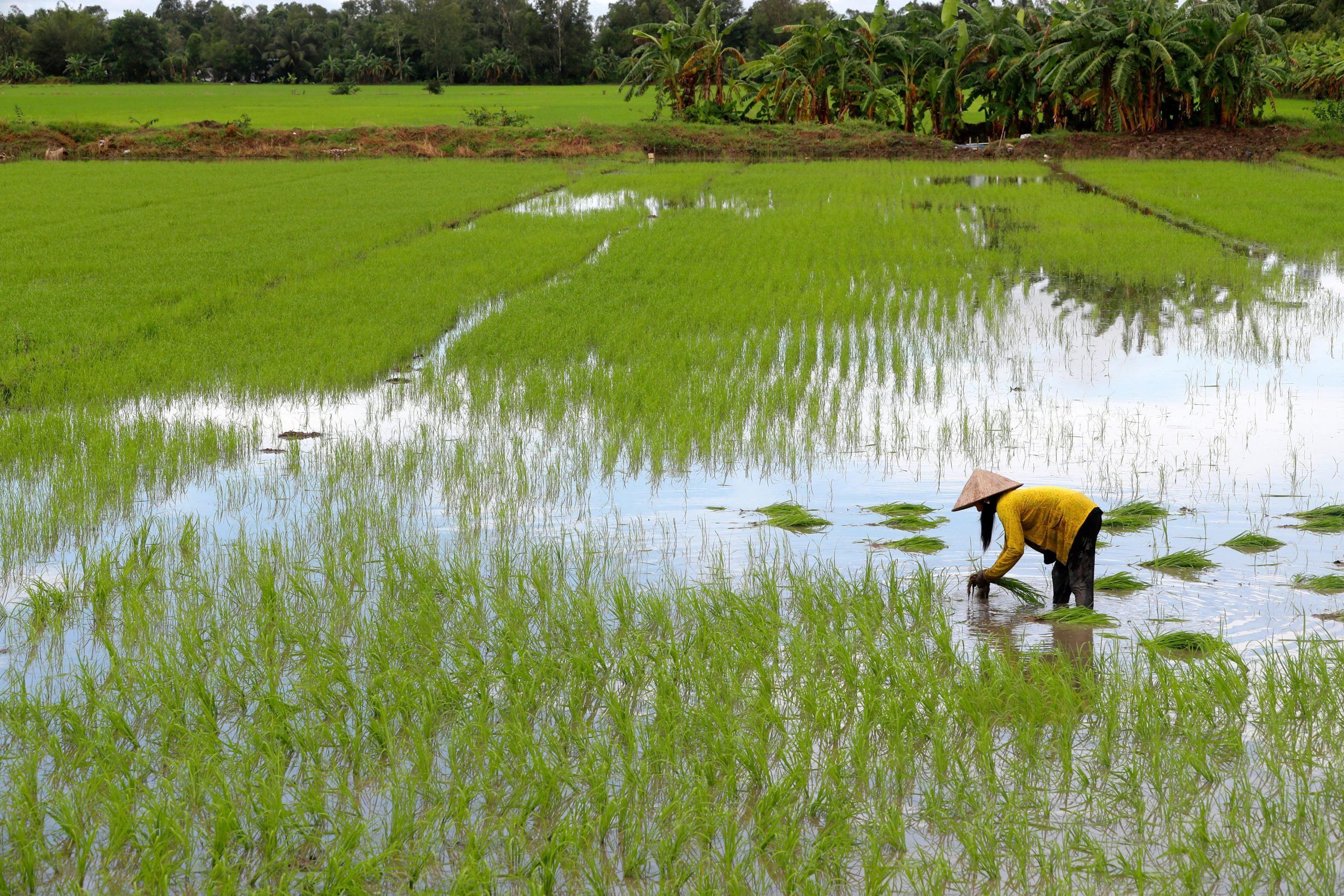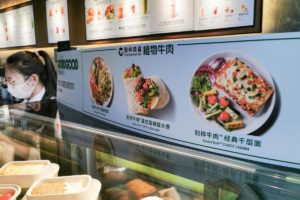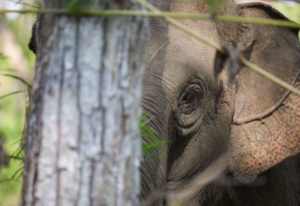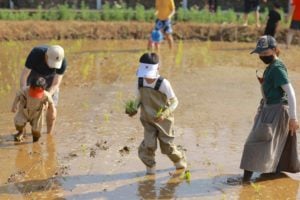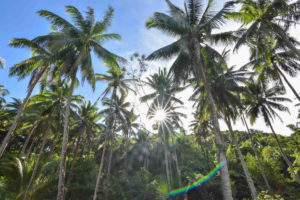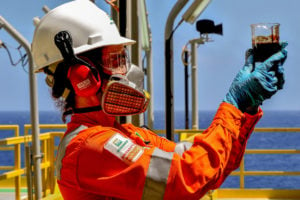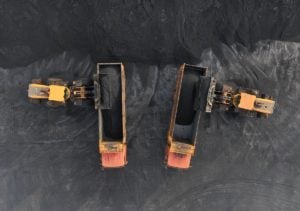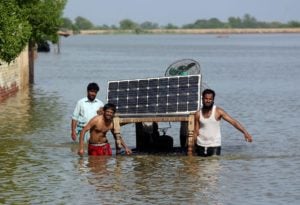Trần Thanh Bảy, a 65-year-old farmer in southern Vietnam, is already anticipating his next rice harvest. It is August and the latest harvest in this district – Tân Thạnh in Long An province, between Ho Chi Minh City and the Mekong Delta – has just concluded. Sitting on a chair in his yard, Bảy shares his rice-tending process. Every day, he wakes up at 4.30am to inspect the crop. For an hour, he diligently checks for pests, ensuring pesticides or fertilisers are sprayed promptly.
Such an attentive process is necessary because this is not typical rice cultivation. Bảy, a member of the Hoàng Gia farming cooperative, has been growing an emissions-reducing variety of rice.
In 2018, Bảy was the chief of his village, Nguyễn Sơn. That year officers from the Ministry of Agriculture and Rural Development approached him about the Vietnam Sustainable Agriculture Transformation Project (VnSAT). This environmentally focused programme aims to enhance both rice yield and grain quality while reducing the crop’s notoriously high methane emissions. Bảy was attracted by the potential benefits of new rice varieties, including reduced emissions and cultivation costs, as well as by the provision of free scientific knowledge to locals.
Inspired, in 2019 Bảy rallied Nguyễn Sơn‘s farmers to take part. They are now among more than 150,000 farmers in Long An and Đồng Tháp provinces who have been participating in VnSAT since its 2015 launch.
But several years into the programme, Bảy is among many participants who are disappointed. They have experienced high costs, lower-than-expected yields and a perceived mismanagement of funds.
A solution to paddy cultivation’s methane emissions
Originally running from 2015 to 2022, VnSAT had a US$301 million budget (7.3 trillion Vietnamese dong) financed through an agricultural enhancement credit agreement between Vietnam and the World Bank. Vietnam’s agriculture ministry oversaw VnSAT’s implementation; each participating province had a different VnSAT start date, which meant that some, such as Long An, were incorporated late into the seven-year timeframe.
VnSAT aimed to help restructure Vietnam’s agricultural sector by supporting sustainable rice and coffee production. Its rice component sought to inform farmers about emissions-reducing farming techniques, change cultivation practices and develop the necessary infrastructure.
The Mekong Delta is Vietnam’s largest rice-producing region: around 1.5 million hectares is dedicated to growing it, which represents approximately 52% of the country’s rice cultivation area. In turn, methane emissions from rice cultivation account for 50% of agricultural emissions in Vietnam and 15% of total national greenhouse gas emissions.
These emissions arise in various ways. Traditional rice farming in the Mekong Delta does not include irrigation management; when water from the canals nears their terraced fields, farmers typically pump it in. This means these fields are consistently covered with water, which creates conditions conducive to methane production. Meanwhile, excessive fertiliser use results in the emission of nitrous oxide, another greenhouse gas. At the end of a harvest, farmers usually burn their fields to clear them, which releases further climate-warming emissions.
Through VnSAT, farmers receive training on two rice cultivation techniques, called “One Must, Five Reductions’ (1M5R) and “Three Reductions, Three Gains” (3R3G). Developed by the International Rice Research Institute (IRRI), these techniques aim to increase rice quality and improve the health of both farmers and their lands.
1M5R’s “must” is to use certified seeds, which will in turn “reduce” the amount of seed, fertiliser, pesticide and water used, as well as post-harvest losses. Certification guarantees seed health and quality; planting fewer seeds minimises competition among plants. 3R3G imposes “reductions” in the use of seeds, nitrogen fertilisers, and pesticides, to “gain” savings in production costs, health benefits for farmers, and environmental protection. These techniques exclusively use organic fertilisers for plant and soil health, and for lower greenhouse gas emissions. Water is conserved by reducing irrigation, which also minimises methane emissions and makes crops more resistant to drought.
Reducing irrigation is especially important as water scarcity bites in the Mekong Delta. This is due to climate change impacts and the presence of dams further along the river – water saved during rice cultivation can be reallocated for other farming needs.
According to results collated by VnSAT and the World Bank’s Agriculture Competitiveness Project (ACP), 1M5R alone has the potential to increase rice yields by roughly 5-8%. And because it uses less seeds, fertilisers and pesticides, production costs shrink by 22% while profits rise by between 29% and 67%.
Economic challenges
In both Đồng Tháp and Long An provinces however, many farmers claim such results have yet to emerge. Those in the Tiến Cường rice farming cooperative in Tam Nông, Đồng Tháp, have found that the IRRI’s techniques require more skills and attention than traditional methods. “Farmers have to work harder because we have to visit the paddy fields more frequently to check rice health,” says Tiến Cường’s leader, Nguyễn Văn Trãi.
Trãi says the returns for such efforts have not been satisfactory: “We put in more time and commitment, but businesses purchase our products at the same price as [those of] traditional rice farmers.”
We understand the environmental benefits of the techniques. However, we struggle daily to make a living, so we prioritise economic benefitsTrần Thanh Bảy, a 65-year-old farmer in southern Vietnam
Bảy notes that, amid high cultivation costs for this new variety of rice, VnSAT did not provide any guarantee on prices. Bảy says this created unease among farmers, especially because the rice market fluctuates greatly. “We want the project to provide [indications of] how much we can possibly sell if we apply the new cultivation methods in our paddy fields,” he adds.
For farmers in the Tiến Cường and Hoàng Gia cooperatives, the IRRI’s methods have not significantly reduced costs. “Organic pesticides cost more than conventional ones,” explains Trãi. “Input costs might [have] decreased [due to planting fewer] seeds, but the effort is higher. The yield is either lower or equivalent to those practising traditional rice cultivation.”
On the other hand, the programme has yielded some benefits. During training, VnSAT officers taught farmers to identify the pests and diseases that affect their yields and the specific pesticides for each. “Previously, the farmers did not know about the diseases affecting rice, so they often used four to five types of pesticides at once. The more pesticides you use, the more money it costs,” Trãi says.
Bảy notes that participating farmers are sympathetic to the aims of the project: “We understand the environmental benefits of the techniques. However, we struggle daily to make a living, so we prioritise economic benefits.”
China Dialogue speaks to Lê Anh Tuấn, the vice director of Can Tho University’s climate change research institute in the Mekong Delta. According to Tuấn, the IRRI cultivation methods promoted by VnSAT effectively reduce emissions, but they need time and scaling to achieve results: “The new farming methods are meaningful when combined with a shift from traditional cultivation practices. Emissions reduction is most effective when these cultivation measures are consistently implemented across a wide area and over an extended period.”
But the time and costs that VnSAT demands have meant some farmers have resorted to partial implementation only. For example, China Dialogue speaks to a Tiến Cường cooperative farmer named Dũng who has reduced his seed quantities and irrigation, but still uses chemical pesticides and fertilisers because they are cheaper.
Such compromises threaten to negate the emissions-reduction benefits of the programme, as chemical fertilisers are a key source of emissions. In 2022, research identified synthetic nitrogen fertilisers as responsible for just over 2% of global greenhouse emissions during 2018 – equivalent to that year‘s total global aviation emissions.
Mismanagement of funds
A key focus of the VnSAT project is to support the development of rice-cultivation infrastructure. This is achieved by stimulating private investment in technology and equipment for high-quality rice processing, as well as the construction of infrastructure to facilitate production and distribution.
But VnSAT-funded infrastructure projects have been criticised by farming communities citing low standards and a lack of utility.
In 2021 for example, VnSAT funded the construction of a 4.5km road that passes Bảy’s house. Designed to facilitate rice transportation, the road has already required multiple repairs. Meanwhile, a bridge next to Bảy’s house, also built in 2021, has developed cracks. “It is very dangerous. The community has been asking for the bridge to be repaired, but it hasn’t been [fully] fixed,” Bảy says. “It’s such a waste of societal resources.”
VnSAT uses its budget to fund and build facilities with specific capacities. Typically, the programme funds a facility and looks for investors – such as private companies or farming cooperatives – to take over maintenance and any capacity expansions. For example, in 2015 the Tiến Cường farming cooperative invested in building a drying and storage facility developed by VnSAT.
However, this facility has since been abandoned. The cooperative invested more than $650,000 into the project, withdrawing investment capital from their other agricultural projects. Once the facility was completed, Tiến Cường discovered that customers preferred to buy rice immediately after the harvest in order to manage quality themselves. “This lack of foresight has caused significant losses for the cooperative,” says Trãi. Tiến Cường has incurred several hundred thousand dollars of losses each year since.
For Nhơn Hòa Lập, another Long An farming commune, VnSAT built a $150,000 pumping station in 2022. This too has been abandoned due to a lack of demand and no investor interest.
Infrastructural projects such as these have been criticised for a lack of community input during early stages. “The [pumping station] project began construction without consulting the local residents,” says a member of the Hoàng Gia cooperative who wishes to remain anonymous. “So, when it was completed, no one used it.”
Suggestions for the future
In March 2023, Vietnam’s agriculture ministry proposed the second phase of VnSAT. It aims to introduce high-quality rice crops across one million hectares by 2030. The World Bank has shown interest in establishing a $20 million grant programme with Vietnamese private banks to arrange the necessary loans for farmers.
The central government must collaborate closely with local authorities to understand what needs to be invested in, and how to invest effectivelyNguyễn Văn Trãi, Tiến Cường’s leader
For future iterations of the programme to receive more buy-in from farmers, however, existing participants who spoke to China Dialogue say there needs to be significant improvement. When it comes to developing optimal infrastructure plans, Trãi says: “The central government must collaborate closely with local authorities to understand what needs to be invested in, and how to invest effectively.”
Trãi adds that VnSAT should establish a “solid link” with businesses to ensure large-scale consumption of its new rice varieties – farmers need to know who they can sell these products to and how much money they can earn.
Currently, the Tiến Cường cooperative sells its rice to small-scale traders, who then sell to major companies. Trãi suggests VnSAT expand to boost rice production volumes, which would make it easier for Tiến Cường to negotiate larger deals and sell directly to big companies. “The quantity of emissions-reduced rice on its own is too minimal for widespread consumption,” he says. “Companies lack the incentive to purchase it at a premium.”
A solution to this lack of incentive could be the creation of a certification for VnSAT rice. According to Trần Phương Nam, who directs the major southern Vietnamese rice producer VinaRice, “we are willing to pay a higher price”. This may require approval and certification by a third party, however. “We need to know the origin of the plant and the rice production process to determine the value of the final product,” says Nam.
Despite the setbacks VnSAT has faced, Trần Thanh Bảy is hopeful he will enjoy a better rice harvest next year and guaranteed rice prices. He also anticipates charging more for his rice, if the project’s second phase materialises. Like Nguyễn Văn Trãi, Bảy hopes local communities will be listened to in future: “VnSAT should survey with farmers in advance to understand what we really want.”
China Dialogue has not yet received a response from the World Bank to its request for comment.
